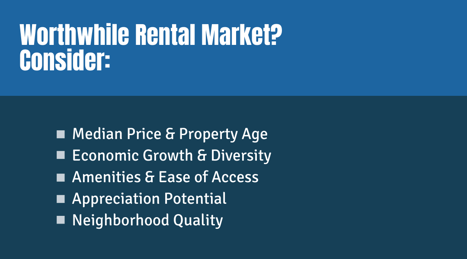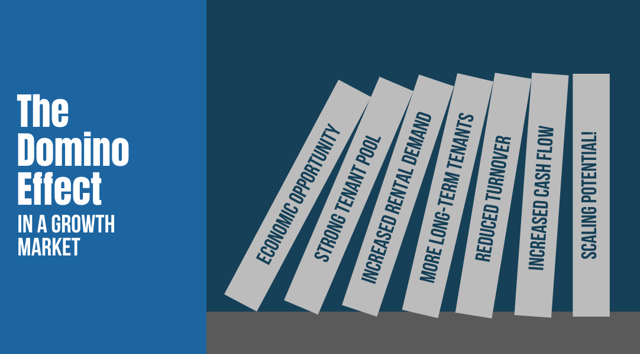 One of the greatest advantages of single-family real estate investment is
One of the greatest advantages of single-family real estate investment is
Each and every market is distinct and different. An investor’s choice in real estate market absolutely matters as each and every market deals with their own economies, supply and demand, and rental needs. For long-term success, every real estate investor must thoroughly investigate their market before they begin searching real estate listings and thinking about purchasing properties.
The Key Components in a Desirable Rental Market
What makes a rental market desirable?
When it comes to rental markets, there are a few key factors that investors should look for as they scope out potential places to invest. More than the factors that are directly associated with the real estate market—which markets are “hot” and have rising home prices or glamorous primary markets—single-family real estate investors should turn to the factors that indicate one key thing: sustainable, long-term growth.
4 Indicators That a Real Estate Market is Healthy
Population Growth
Population growth is one of the key indicators of the health of any market. One of the things that single-family real estate investors want in their given market is steady, healthy population growth. It’s an indicator of the overall health in their city, town, or neighborhood. An influx of people typically indicates economic opportunity and growth, which in turn positively impacts things like
The population also affects demographics, which has a significant impact on opportunities for real estate investors as it relates to their tenants. For example, a population that is comprised mostly of Baby Boomers will likely be looking to downsize and retire. A population that skews young with millennials will likely have many renters, either through lifestyle choices or necessity. The needs of these markets will be drastically different!
Economic Growth
The second indicator to observe is economic growth. Is industry coming to your market? Even if you aren’t a commercial real estate investor, it pays to pay attention to the commercial and retail sectors. See what businesses are moving in or out.
There is a link between the economy, the real estate market, and the rental market. If the economy is strong and wages are strong, people are moving in. If people are moving in and making money, they will want to buy houses. Housing demand increases. Prices increase. As a result, rental demand increases and so does rental income.
Steady Price Fluctuations
In “hot” real estate markets, we tend to see wild price fluctuations. While these can offer thrilling investment opportunities, they tend to burn out fast and bright. That’s because rapidly increasing prices can only increase for so long. While investors that are quick on the draw may be able to take advantage of rapid appreciation in such markets, they may find that a crash is just around the corner.
That’s because severe pendulum swings in price and value just aren’t sustainable for the long-term. For buy-and-hold investors especially, it’s not about getting swept up in rollercoaster markets. It’s about honing in on the reliable, steady markets that will provide predictable returns. A healthy real estate market is one that is even and steady in their growth.
Typically, investors should look for markets that experience a 5% annual increase in home prices.
The danger in the markets that do have rapidly
Even after Hurricane Harvey devastated the city, the New York Times called Houston’s real estate market “unsinkable”, as the city continues to draw in thousands of people each day, retains high housing demands, and provides an affordable-in-comparison alternative to cities like New York City and San Francisco.
While Houston has yet to have the pendulum swing the other way despite the oil crash in recent years and one of the biggest natural disasters in a decade, other markets aren’t so lucky.
The danger, again, is in seizing upon rapid appreciation without considering a market’s long-term health.
Month’s Supply & Time on Market
As classic indicators of real estate market health, investors can look to inventory supply and time on the market as an indicator of overall market health. Everything in real estate investment is about balance. Month’s supply is about the balance between supply and demand. Too much demand without supply increases prices. The opposite, and they decrease. A six-month supply is considered healthy.
Similarly, time on the market for that supply is an indicator of health. While it’s not as accurate as month’s supply because a property can be delisted and listed again (thus resetting its time on market), one can take a cursory glance on an MLS and see, in general, how long listings have been on the market, how many new listings pop up each day, and if inventory is moving. If the market seems slow, it could indicate any number of problems: lack of buyers, lack of buyer confidence, issues with the property, too-high prices, or general lack of demand.
What are the major factors to consider in any given market?

As a real estate investor looking to invest in single-family properties, there are specific factors worth your consideration when investigating particular markets. That’s not just including a market as a whole, like a city or a town, but in more specific terms as well, like districts and neighborhoods.
Cities, especially large ones, are full of markets within markets: if you’re only looking at the large, zoomed-out chunk, you’re not going to get the whole picture that you need to make a wise investment decision.
Median Price
Price, obviously, is a hugely important factor when considering whether or not you want to invest in a given area or property. For most real estate investors utilizing a traditional buy and hold strategy, you’re looking to buy low. There’s a trick to it, though! Buying too low comes with its fair share of problems. A home that is listed at an incredibly low price is usually that way for a reason. You always get what you pay for, and sometimes you end up paying more than you think when your property winds up having
The trick to picking a market to invest in is picking one that is affordable to you. It always goes back to the numbers. You want to choose a market that you can comfortably compete in, one that will provide cash flow, and one that will be manageable to scale in.
Age of Properties
Certain markets are older than others. For example, east coast markets tend to have more historical neighborhoods than west coast markets. Within cities, you will almost always encounter a historical neighborhood. Age of properties is something to consider: while they may be cheaper, they often come with issues that you won’t encounter as readily with newer construction. Asbestos, mold, odd layouts, cramped storage space, and just a bigger need for TLC are all on the table.
Economy, Industry, Education
We’ve already covered how the economic health of a market is crucial to its investment potential. But worth considering are the specific building blocks of that market’s economy and industry. Even if these seem like secondary details, they’re important when taking into account that buy-and-hold investors plan to be involved in a market for the long haul.
Example: you buy a rental property in an economically strong small city in the midwest. This city’s economy hinges on the employment provided by a single manufacturer that has a factory nearby. A few years later, the manufacturer pulls out and those jobs disappear overnight. Rental demand vanishes, prices bottom out, and real estate values plummet.
Another example. We’ve already talked about Houston. So many experts were terrified that Houston’s economy was going to collapse (and by extension, its real estate market) with the oil bust in recent years. It happened in the late 80s—why couldn’t it happen again?
It didn’t happen because Houston’s economy has diversified since then. We have to consider the economic makeup of the markets we involve ourselves in. Does the economy rely on one primary employer? One industry? How much education does the economy as a whole demand? What are the median wages in the market? These are important questions to ask.
Amenities & Access
One big consideration in a market are the things that would draw tenants to live there over other places. This is particularly important when considering specific neighborhoods, districts, and areas to invest in within a market as a whole. Get into the mind of the consumer and think about what they value and how you may ultimately market your property. What amenities does your market offer? Quick access to major business districts? Proximity to universities and high-quality school districts?
This is a time to examine things like the influx and growth of businesses in your markets. Population growth plays a role in that as economic development will go hand-in-hand with an influx of people. Knowing, however, that your market has vibrant, attractive qualities—things beyond you and your property that will make your tenants want to live, work, and enjoy that market—will be a great benefit to you.
Appreciation Potential
While appreciation is not the driving force behind a passive single-family real estate investor’s income, it is something worth looking for. Investors should be searching out markets that have appreciation potential. Can you do this accurately? No. That’s why it’s always secondary to your passive income earning potential. Appreciation is based on speculation. It’s not concrete, so you can’t rely on it.
That said, there’s nothing wrong with trying to capitalize on emerging markets and honing in on the “next big thing,” when looking to invest. It may be like catching lightning in a bottle, but sometimes it pays off in a big way.
Quality of the Neighborhood
On a zoomed-in level, investors must consider the quality of the neighborhoods they choose to invest in. As always, it’s not enough to just look at individual properties. Quality neighborhoods are a crucial piece of the puzzle.
Some of the key factors to look for:
- Signs of decline. Things like cheap apartments, lots of for sale signs, vacant businesses, and a lack of upkeep on properties are all red flags. You can only control your property’s quality. If the area is declining, there’s not much you can do on your own.
- Quality of life. Here’s an exercise. If you’re thinking of investing in a neighborhood, picture yourself living there. Would you be able to go about your day with the same routine that you enjoy? How long would your route to work (or in this case, a major business district) take? How about getting to the grocery store? Shopping? A neighborhood coffee shop? Put yourself in the shoes of a parent. Can you easily get to a safe park? Schools? Family-friendly amenities?
- Public services. You can get a fairly quick idea of the state of a town or city’s public services by looking at what usually gets cut first when tax income is squeezed: libraries, parks, and police. Are the streets clean? Public spaces well-maintained? These are valuable not only from an aesthetic standpoint, but they’re key indicators of market health on a level that can’t necessarily be changed by the same factors that others can.
Why does your real estate market matter?
So we know what some of the things to look for in a market are when considering a real estate investment, but why exactly does it matter? Why can’t a real estate investor just invest right where they are? After all, isn’t it wise to invest locally? Many will say that there’s a lot of risk in remote real estate investment.
Investing in your local real estate market isn’t always the best option. That’s because where you live isn’t always the best rental market, the most affordable market, or the market with the
The market you choose can drastically impact the long-term success of your investments. It’s not just about appreciation, it’s about reducing the struggle and risk you’ll contest with during your whole investment journey.
These are just some of the dangers you may face if you wind up in a bad rental market.
The Dangers of a Bad Rental Market
Property Value
This is numero uno when investors think about buying in a bad rental market. When you buy a property, you should primarily buy with cash flow in mind, but that doesn’t mean that property value and appreciation are non-factors. They matter. You may think otherwise because, as a buy-and-hold investor, you have no intention of selling anytime soon and you can ride out any bad spells and wait for a turnaround. But what if circumstances demand otherwise? We can’t predict the future.
It’s far better to bank on a property and a market that has growth potential than to be blasé and risk a heavy loss.
Low Rental Demand
Just like homes on the market for sale, rental properties are subject to supply and demand. As a real estate investor, it’s crucial to take that balance into account when you buy. What is the state of affairs where you’re buying? Within the market, where is there a need for more rentals? Where is there an oversaturation? It’s not just about single-family rentals, either—apartments are competition, too.
We have to consider their prices and whether or not that income makes sense with the cost of the properties. Low demand drives down your income earning potential. What affects demand? A lot of factors, but not so different from what you would expect: excess supply (too many other rentals on the market) and a lack of demand (this can be affected by many factors; low home costs, decreasing population, economic decline, etc.).
Exit Strategy
In real estate, your “exit strategy” refers to the method in which you offload a property. Typically, it means selling it, though when and to whom is where the strategy comes in. For buy-and-hold investors, an exit strategy isn’t often top-of-mind. It’s distant and low priority. Think about this, though: what if you want to refinance your property at some point? The value of your property matters, then, too. You don’t want to be in a declining market and be stuck wanting to refinance or sell your property. Not only will you likely lose in your deal, but you’ll find yourself wrestling to find buyers and it will likely take more time and energy to exit than you’d like.
Rental Income
We’ve already mentioned rental demand, but what about the specific ways a declining real estate market can affect your rental income? Obviously, a lack of demand can drive down the overall rental prices down. Not only can it decrease your cash flow, but it can cut it off. With lowered demand, you increase your chances of prolonged vacancies in times of turnover. Investors know vacancy periods are the most expensive times to be a real estate investor.
Lack of demand, decreases in population, etc., can also affect tenant quality, which can affect the stability of your income streams, regardless of vacancies and turnover rates.
The Potential in a Growth Market
The Domino Effect
If a declining real estate market brings risk, it’s only natural that a growth market brings opportunity. There’s a domino effect for real estate investors to consider that very neatly breaks down why it’s so important to focus on finding and investing in a growth market.

Breaking Down Growth Potential for Passive Real Estate Investors
Long-Term Quality Tenants
When we look a little closer at the value of some of the key pieces that benefit real estate investors in a growth market, long-term, quality tenants are at the top of the list. There’s no understating the value of quality tenants. In a market where there
Stable & Growing Rental Income
In a growth market, you should reasonably expect that as demand grows for rentals, you will be able to grow your rental income as time goes on. You will find that as housing demands increase, so do rental demands and prices—which is good news for investors.
Scaling Potential
As a real estate investor, you should not be content with a single rental property. Building your financial future takes more than one investment! Here’s where a growth market comes in: if you are invested in a market that is constantly helping you grow with what you have (in income, in appreciation) then you will more quickly be able to take advantage of new investment opportunities, scale your portfolio, and work towards achieving your investment goals. It’s the difference between smooth sailing and fighting an uphill battle.
Related Article: 6 Tips on How to Grow Your Real Estate Portfolio
So How Do I Analyze a Real Estate Market?
Knowing the why is a start. Knowing some of the things to look for in a real estate market when evaluating potential investment opportunities is also valuable. But how should an investor evaluate a market in a practical, tangible way? What is quick and efficient?
There’s a trick every investor should know, and it starts with CAFR.

Reading Financial Statements for Real Estate Investors
Picked a market? That’s a start. Before you do anything else, look for a city’s latest Comprehensive Annual Financial Report (CAFR). These documents are compiled by the city government and audited by an outside firm. They catalog a ton of information that can be used by real estate investors to quickly assess market vitality.
Key statistics in a CAFR:
- Population trends and demographics
- Unemployment rates & economic diversity
- City net position & outstanding debts
- Yearly shifts in property taxes
- Top ten employers / top ten taxpayers
- Median age & income
Similarly, it is helpful to go through websites like city-data.com, which offers similar statistics from government and private sources as well as some tools that may be helpful when comparing different cities to one another. The financial and demographic data from a market is incredibly telling when you want to learn a lot very quickly about an area’s investment potential.
Turnkey Real Estate Investment for Pre-vetted Markets?
Navigating rental markets is no small feat. For real estate investors, the ins-and-outs of evaluating and choosing where to invest can be time-consuming, frustrating, and challenging. Thankfully, it doesn’t have to be. For single-family real estate investors, there’s a solution to the hassle of evaluating rental markets, sifting through data, and banking on predictions: turnkey real estate investment.
Turnkey real estate providers spend a great deal of time targeting the markets that they do their business in. After all, a lot is hinging on it! They do all of the research and vetting that you would ever hope to do on top of finding, buying, and renovating the properties that have the best investment potential.
Ultimately, no rental market is a shoe-in. There is always risk associated with single-family real estate investment and any market that you choose to invest in. That said, there’s more or less risk in different markets at different times depending on economics and how the pendulum swings.
It is up to each and every one of us to do our due diligence to ensure that we are making informed choices that not only yield short-term income but set up long-term investment success.
You can start building wealth today in the same great markets with thousands of passive real investors when you partner with Memphis Invest.












